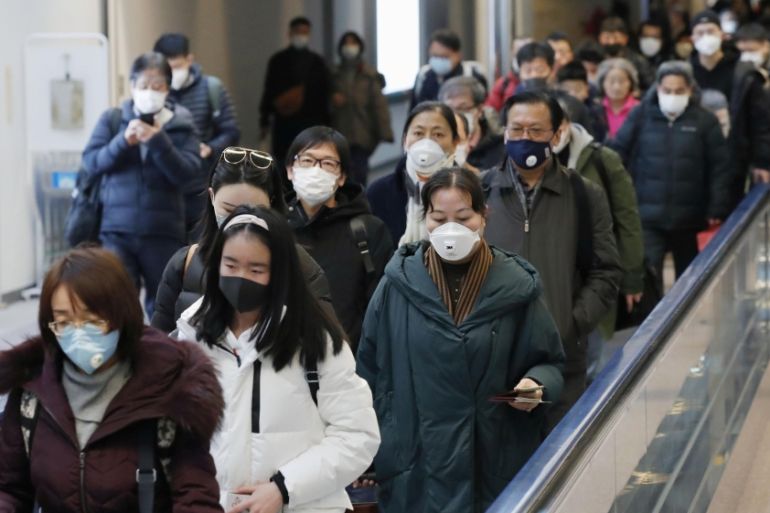By the numbers: Economic effects of China coronavirus
China and other Asian economies face losses in tourism, aviation, retail and entertainment sectors due to the virus.

Suspended flights, cancelled tours, temporary restaurant closures, and millions of people in lockdown amid an extended nationwide holiday are just some of the results of a contagious new coronavirus that has caused more than 80 deaths in China.
At the epicentre of the outbreak is Wuhan, a Chinese city of more than 11 million people, where the disease was first recorded and is now home to the highest number of cases.
Keep reading
list of 4 itemsMexico’s teachers seek relief from pandemic-era spike in school robberies
‘A bad chapter’: Tracing the origins of Ecuador’s rise in gang violence
Why is the US economy so resilient?
Touted as China’s Chicago, fast-growing Wuhan was expected to record a regional economic growth rate of up to 7.8 percent in 2020, according to local government estimates. This would make it a key pillar of growth in China’s sluggish economy, which is expected to grow by just 6 percent, according to central government figures.
However, as shutters roll down in shops and public transportation comes to a standstill as the coronavirus spreads, one of China’s brightest economic spots could end up dimming the prospects of a country already struggling with its weakest economic growth in 29 years.
China said on Monday that its finance ministry and National Health Commission have extended 60.33 billion yuan ($8.74bn) to help contain the virus.
International airlines ranging from Taiwan’s China Airlines to Singapore’s Scoot have cancelled flights to and from Wuhan. According to data from aviation data analytics firm Cirium, Wuhan receives 55 international flights each week from more than 20 countries.
In response to questions from Al Jazeera, AirAsia and Cathay Pacific referred to official statements regarding the suspensions of flights from Wuhan.
As of Sunday, Cathay Pacific extended the suspension of its flights to and from Wuhan until the end of March and allowed crew members and front-line airport employees to wear face surgical masks.
Meanwhile, AirAsia has temporarily cancelled all flights from Kota Kinabalu in Malaysia, Bangkok and Phuket to Wuhan until January 28, resulting in some three flights suspended daily, based on their weekly frequency schedule.
Passengers have been offered full refunds, and the opportunity to book a new travel date within 30 days, or credit an AirAsia account to be used within 90 days, the airline said.
Neither airline responded directly to questions about the costs they might incur from the suspensions of their daily flights to Wuhan.
As consumption spending has become the most important growth driver for the Chinese economy in recent years, a key near-term risk is a negative effect the virus has on Chinese consumer sentiment, according to Rajiv Biswas, chief economist for Asia Pacific at IHS Markit.
“With many entertainment venues in China, including an estimated 11,000 cinema theatres as well as major resorts such as the Disneyland park in Shanghai having temporarily closed due to the Wuhan virus outbreak, the immediate negative impact on China’s entertainment industry is already significant,” he said in a note shared with Al Jazeera.
Other Asia-Pacific countries are also vulnerable to a further economic slowdown in China, as well as a decline in Chinese tourism as the country imposes travel bans on outgoing group tours, Biswas said.
“The rapid rise in household incomes in China has triggered a boom in Chinese tourism visits abroad, which have risen from 20 million in 2003 to 150 million in 2018. Consequently, the vulnerability of many Asia-Pacific economies to a slowdown in Chinese tourism visits has increased significantly over the past two decades,” he said.
How bad can it get?
On Monday, shares of tour operators fell in Thailand and Japan as China banned outbound group tours to contain the spread of the virus.
Singapore is also bracing for economic fallout from the virus.
“We certainly expect there to be an impact on our economy, business and consumer confidence this year, especially as the situation is expected to persist for some time,” Singapore’s Trade Minister Chan Chun Sing said on Monday.
At a news conference, Chan said Singapore’s government is considering support measures for hard-hit sectors such as tourism.
Chinese nationals make up the largest share of visitors to Singapore, one of the worst-hit countries outside of China in the 2003 outbreak of Severe Acute Respiratory Syndrome (SARS), another strain of the coronavirus which killed 800 people globally.
A 2018 study estimated that another global influenza pandemic could kill 720,000 people and cost $500bn, or 0.6 percent of global income per year.
That is within the range of estimated global losses from global warming (between 0.2 percent and 2 percent of global income).
Lower and middle-income countries would suffer the most, with an estimated 1.6 percent of annual income lost if an influenza pandemic occurred.
High-income countries are expected to lose about 0.3 percent of the annual income.
China-wide, if spending on things including discretionary transport and entertainment dropped by 10 percent, overall gross domestic product (GDP) growth would fall by about 1.2 percentage points, according to “back of the envelope” estimates from Shaun Roache, chief economist for the Asia Pacific region at global ratings agency Standard & Poor’s.